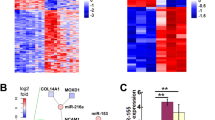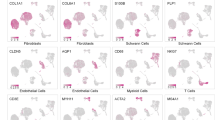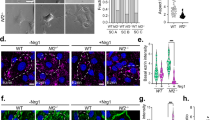Abstract
Neurofibromatosis type 1 (NF1) patients are predisposed to neurofibromas but the driver(s) that contribute to neurofibroma formation are not fully understood. By cross comparison of microarray gene lists on human neurofibroma-initiating cells and developed neurofibroma Schwann cells (SCs) we identified RUNX1 overexpression in human neurofibroma initiation cells, suggesting RUNX1 might relate to neurofibroma formation. Immunostaining confirmed RUNX1 protein overexpression in human plexiform neurofibromas. Runx1 overexpression was confirmed in mouse Schwann cell progenitors (SCPs) and mouse neurofibromas at the messenger RNA and protein levels. Genetic inhibition of Runx1 expression by small hairpin RNA or pharmacological inhibition of Runx1 function by a Runx1/Cbfβ interaction inhibitor, Ro5-3335, decreased mouse neurofibroma sphere number in vitro. Targeted genetic deletion of Runx1 in SCs and SCPs delayed mouse neurofibroma formation in vivo. Mechanistically, loss of Nf1 increased embryonic day 12.5 Runx1+/Blbp+ progenitors that enable tumor formation. These results suggest that Runx1 has an important role in Nf1 neurofibroma initiation, and inhibition of RUNX1 function might provide a novel potential therapeutic treatment strategy for neurofibroma patients.
This is a preview of subscription content, access via your institution
Access options
Subscribe to this journal
Receive 50 print issues and online access
$259.00 per year
only $5.18 per issue
Buy this article
- Purchase on Springer Link
- Instant access to full article PDF
Prices may be subject to local taxes which are calculated during checkout




Similar content being viewed by others
References
McCormick F . Ras signaling and NF1. Curr Opin Genet Dev 1995; 5: 51–55.
Le LQ, Parada LF . Tumor microenvironment and neurofibromatosis type I: connecting the GAPs. Oncogene 2007; 26: 4609–4616.
Blatt J, Jaffe R, Deutsch M, Adkins J . Neurofibromatosis and childhood tumors. Cancer 1986; 57: 1225–1229.
Friedman J . Epidemiology of neurofibromatosis type 1. Am J Med Genet 1999; 89: 1–6.
Kim HA, Ling B, Ratner N . Nf1-deficient mouse Schwann cells are angiogenic and invasive and can be induced to hyperproliferate: reversion of some phenotypes by an inhibitor of farnesyl protein transferase. Mol Cell Biol 1997; 17: 862–872.
Cichowski K, Shih TS, Schmitt E, Santiago S, Reilly K, McLaughlin ME et al. Mouse models of tumor development in neurofibromatosis type 1. Science 1999; 286: 2172–2176.
Zhu Y, Ghosh P, Charnay P, Burns D, Parada L . Neurofibromas in NF1: Schwann cell origin and role of tumor environment. Science 2002; 296: 920–922.
Mayes DA, Rizvi TA, Cancelas JA, Kolasinski NT, Ciraolo GM, Stemmer-Rachamimov AO et al. Perinatal or adult Nf1 inactivation using tamoxifen-inducible PlpCre each cause neurofibroma formation. Cancer Res 2011; 71: 4675–4685.
Wu J, Williams JP, Rizvi TA, Kordich JJ, Witte D, Meijer D et al. Plexiform and dermal neurofibromas and pigmentation are caused by Nf1 loss in desert hedgehog-expressing cells. Cancer Cell 2008; 13: 105–116.
Le LQ, Shipman T, Burns DK, Parada LF . Cell of origin and microenvironment contribution for NF1-associated dermal neurofibromas. Cell Stem Cell 2009; 4: 453–463.
Jouhilahti EM, Peltonen S, Callens T, Jokinen E, Heape AM, Messiaen L et al. The development of cutaneous neurofibromas. Am J Pathol 2011; 178: 500–505.
Zheng H, Chang L, Patel N, Yang J, Lowe L, Burns DK et al. Induction of abnormal proliferation by nonmyelinating schwann cells triggers neurofibroma formation. Cancer Cell 2008; 13: 117–128.
Nagamachi A, Htun PW, Ma F, Miyazaki K, Yamasaki N, Kanno M et al. A 5' untranslated region containing the IRES element in the Runx1 gene is required for angiogenesis, hematopoiesis and leukemogenesis in a knock-in mouse model. Dev Biol 2010; 345: 226–236.
Ichikawa M, Asai T, Saito T, Seo S, Yamazaki I, Yamagata T et al. AML-1 is required for megakaryocytic maturation and lymphocytic differentiation, but not for maintenance of hematopoietic stem cells in adult hematopoiesis. Nat Med 2004; 10: 299–304.
Inoue K, Shiga T, Ito Y . Runx transcription factors in neuronal development. Neural Dev 2008; 3: 20.
Aldskogius H, Berens C, Kanaykina N, Liakhovitskaia A, Medvinsky A, Sandelin M et al. Regulation of boundary cap neural crest stem cell differentiation after transplantation. Stem Cells 2009; 27: 1592–1603.
Simeone A, Daga A, Calabi F . Expression of runt in the mouse embryo. Dev Dyn 1995; 203: 61–70.
Theriault FM, Nuthall HN, Dong Z, Lo R, Barnabe-Heider F, Miller FD et al. Role for Runx1 in the proliferation and neuronal differentiation of selected progenitor cells in the mammalian nervous system. J Neurosci 2005; 25: 2050–2061.
Murthy M, Bocking S, Verginelli F, Stifani S . Transcription factor Runx1 inhibits proliferation and promotes developmental maturation in a selected population of inner olfactory nerve layer olfactory ensheathing cells. Gene 2014; 540: 191–200.
Chimge NO, Frenkel B . The RUNX family in breast cancer: relationships with estrogen signaling. Oncogene 2012; 32: 2121–2130.
Scheitz CJ, Lee TS, McDermitt DJ, Tumbar T . Defining a tissue stem cell-driven Runx1/Stat3 signalling axis in epithelial cancer. EMBO J 2012; 31: 4124–4139.
Planaguma J, Diaz-Fuertes M, Gil-Moreno A, Abal M, Monge M, Garcia A et al. A differential gene expression profile reveals overexpression of RUNX1/AML1 in invasive endometrioid carcinoma. Cancer Res 2004; 64: 8846–8853.
Scheitz CJ, Tumbar T . New insights into the role of Runx1 in epithelial stem cell biology and pathology. J Cell Biochem 2013; 114: 985–993.
Williams JP, Wu J, Johansson G, Rizvi TA, Miller SC, Geiger H et al. Nf1 mutation expands an EGFR-dependent peripheral nerve progenitor that confers neurofibroma tumorigenic potential. Cell Stem Cell 2008; 3: 658–669.
Miller SJ, Jessen WJ, Mehta T, Hardiman A, Sites E, Kaiser S et al. Integrative genomic analyses of neurofibromatosis tumours identify SOX9 as a biomarker and survival gene. EMBO Mol Med 2009; 1: 236–248.
Cunningham L, Finckbeiner S, Hyde RK, Southall N, Marugan J, Yedavalli VR et al. Identification of benzodiazepine Ro5-3335 as an inhibitor of CBF leukemia through quantitative high throughput screen against RUNX1-CBFbeta interaction. Proc Natl Acad Sci USA 2012; 109: 14592–14597.
Jaegle M, Ghazvini M, Mandemakers W, Piirsoo M, Driegen S, Levavasseur F et al. The POU proteins Brn-2 and Oct-6 share important functions in Schwann cell development. Genes Dev 2003; 17: 1380–1391.
Bushweller JH . CBF—a biophysical perspective. Semin Cell Dev Biol 2000; 11: 377–382.
Motoda L, Osato M, Yamashita N, Jacob B, Chen LQ, Yanagida M et al. Runx1 protects hematopoietic stem/progenitor cells from oncogenic insult. Stem Cells 2007; 25: 2976–2986.
Logan TT, Villapol S, Symes AJ . TGF-beta superfamily gene expression and induction of the Runx1 transcription factor in adult neurogenic regions after brain injury. PloS One 2013; 8: e59250.
Acknowledgements
We thank Dr Nancy Ratner for providing the microarray data (supported by NS28840 to NR) and critical review and helpful discussions of the manuscript. This work was supported by a Cincinnati Children’s Hospital Trustee Grant to JW.
Author information
Authors and Affiliations
Corresponding author
Ethics declarations
Competing interests
The authors declare no conflict of interest.
Additional information
Supplementary Information accompanies this paper on the Oncogene website
Supplementary information
Rights and permissions
About this article
Cite this article
Li, H., Zhao, X., Yan, X. et al. Runx1 contributes to neurofibromatosis type 1 neurofibroma formation. Oncogene 35, 1468–1474 (2016). https://doi.org/10.1038/onc.2015.207
Received:
Revised:
Accepted:
Published:
Issue Date:
DOI: https://doi.org/10.1038/onc.2015.207
This article is cited by
-
Runx1/3-driven adaptive endoplasmic reticulum stress pathways contribute to neurofibromagenesis
Oncogene (2023)
-
EGFR-Stat3 signalling in nerve glial cells modifies neurofibroma initiation
Oncogene (2017)
-
RETRACTED: Role of HCP5-miR-139-RUNX1 Feedback Loop in Regulating Malignant Behavior of Glioma Cells
Molecular Therapy (2016)



